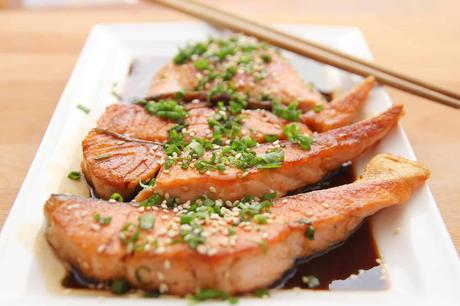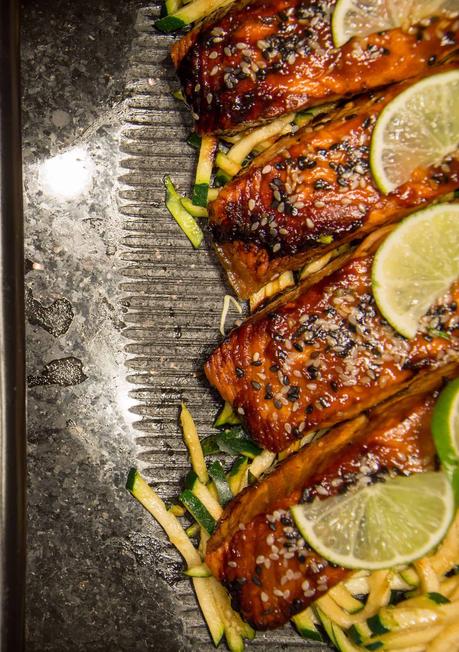Hoisin and teriyaki, they look quite similar, don’t they?
They’re both quite dark and used for glazing, but they are not at all alike.
Let’s take a closer look at the two sauces shall we?

Hoisin sauce is a thick, fragrant, pungent sauce used frequently in Asian vegetable stir-fries, marinades, and grilled dishes.
It is often used in a lot of Chinese cuisines as well as some Vietnamese recipes (the tradition was probably passed on centuries ago from China to Vietnam via trade or intermingling of cultures), it is also referred to as “Chinese BBQ sauce.”
Now let’s compare it to Teriyaki sauce to give you a quick answer: Is hoisin sauce like Teriyaki?
Hoisin sauce is Chinese and based on fermented soybean paste, whereas teriyaki sauce only has a small component of soy sauce. Hoisin sauce is therefore much thicker and saltier compared to its Japanese counterpart as teriyaki sauce tends to be sweeter.
Plus teriyaki isn’t even really Japanese, it originated in Hawaii!
Hoisin sauce is also somewhat spicier compared to teriyaki sauce, but you’ll probably appreciate both when using them as glazing for your next grilling recipe.
There are some foods that work better with hoisin and some with teriyaki, and let’s look at why.
Hoisin sauce
Hoisin sauce is commonly used in Chinese dishes to glaze meat, but chefs also use it for stir-fry recipes and as a dipping sauce. It has a deep dark crimson appearance and has a sweet and salty taste that perfectly blends with grilled meat to the taste.
Hoisin sauce uses common Chinese ingredients such as garlic, red chili peppers, fennel, and soybeans; however, there are also regional variants that use different ingredients. Other ingredients include sugar, five-spice powder, and vinegar.
The word hoisin is a combination of 2 Chinese words (Cantonese 海鮮, hoi, and Mandarin 罪, sin) and is supposed to literally translate to “seafood” in English.
However, it doesn’t contain any seafood ingredient, so the term is somewhat misleading, or perhaps the general taste of the sauce or that it smells like fish or seafood is why they called it as such.
These words are often used to describe seafood flavor.
Ingredients
The base ingredient of hoisin sauce is fermented soybean paste (that’s why you’ll notice it’s thick and sticky).
Hoisin sauce in Beijing style (or is popular in Beijing) has these ingredients in it:
- Fermented black soybean paste
- Starch (from sweet potato)
- Wheat
- Rice
- Water
- Sugar
- Soybeans
- Sesame Seeds
- White Distilled Vinegar
- Salt
- Garlic
- Red Chili Peppers
- Food coloring
- Preservatives
- And it often has Chinese Five Spice powder in it
Here is how it’s made:
Basics of Hoisin Sauce
The basis for hoisin sauce is the fermented soybean paste that is also laced with several flavors and spices.
Hoisin sauce is vegetarian and vegan-friendly as it doesn’t contain any animal products, although traditionally it is the sauce you’d use for the Cantonese Peking duck.
You should note that hoisin is made from fermented soybeans which means that it contains gluten and if you’re on a gluten-free diet, then you might consider getting a different sauce or get a hoisin sauce that’s not soy-based.
Then again, so is teriyaki sauce because of the soy.
Check out all this information on Japanese food if you have some time
Origins
Little is known about the origins of hoisin sauce other than that it is Cantonese.
Hoisin means seafood but doesn’t contain any.
However, as there are some gaps in its history, it might have had some seafood elements in it in order to give the umami flavor necessary to accentuate the taste of the sauce.
Even nobody remembers the last time the sauce was used for any seafood recipe, so the name and origin of the sauces remains a complete mystery.
Taste

Hoisin sauce has a very strong salty and sweet flavor that makes it a great pair with any BBQ recipe or stir-fry cuisine.
If you’re not familiar with both the hoisin sauce and the American-style barbecue sauce, then they may seem to taste the same.
However, those who have tried these sauces many times will know that hoisin is much saltier, richer, and not as sweet as Western-style BBQ sauce.
Also read: Japanese dining for sushi or sashimi, what are the differences?
Benefits of hoisin sauce
Hoisin sauce is a great way to add a unique Asian flavor profile to your growing list of food recipes.
On a medical note, if your doctor restricts you from eating high sodium foods, then you may want to omit it from your spice cabinet.
But the majority of hoisin sauce’s ingredients have a lot of health benefits, so unless otherwise prescribed by your doctor or any allergies to one of its ingredients, you can safely eat it.
Teriyaki
Teriyaki is one of the many Japanese cooking techniques where foods are broiled or grilled and are glazed with a specially made teriyaki sauce.
It is however a Hawaiian invention created by Japanese immigrants who settled down there and used brown sugar to make a thick marinade.
It’s still mostly used for fish recipes (such as mackerel, trout, salmon, tuna, skipjack, marlin, and yellowtail), while in the States it has also moved towards white and red meat such as beef, lamb, pork, and a lot of chicken.
Teriyaki Sauce
The teriyaki sauce, by default, should only be used for teriyaki recipes as it will not bring out the best in other foods.
The typical ingredients for a teriyaki sauce include:
- Water
- Soy Sauce
- Brown Sugar
- Honey
- Ginger
- Garlic Powder
- Sesame Oil
- Cornstarch
- Mirin
It is easy to mix up the two when you place hoisin and teriyaki side by side. In fact, most people do think that they are similar or the same, when they are not.
Also read: is teriyaki sauce traditional, or where did it come from?
The Difference Between Hoisin Sauce and Teriyaki Sauce
That’s a lot of info right there!
But going back to our question, is hoisin sauce like teriyaki sauce? Well, the obvious answer is, no.
While they may look similar in terms of their thickness, color, texture, and even a bit in their taste, you would notice the difference instantly at closer inspection.
For one thing, hoisin sauce is based on fermented soybean paste, whereas teriyaki sauce only has a small component of soy sauce.
Hoisin sauce is much thicker and saltier compared to its Japanese counterpart as teriyaki sauce tends to be sweeter.
Also read: Japanese soup tradition and recipes
